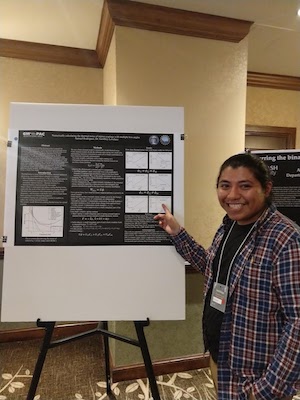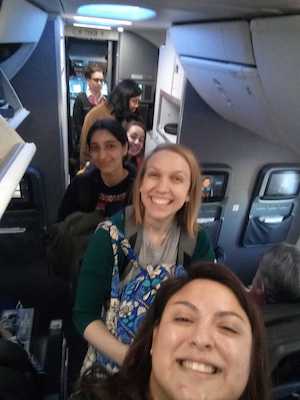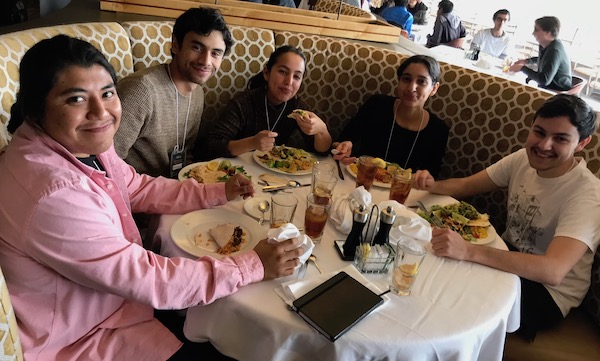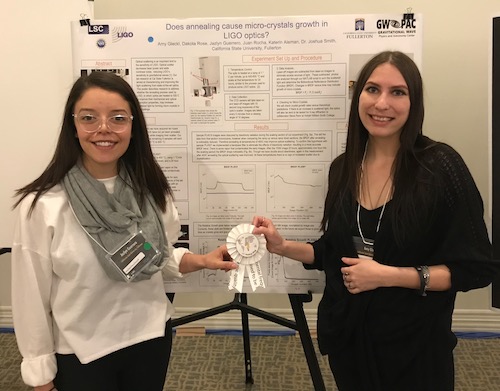2019-2021 Highlights
2021
GWPAC Members Make Waves at 2021 APS and LIGO-Virgo-Kagra Meetings
Members of the Nicholas and Lee Begovich Center for Gravitational-Wave Physics and Astronomy (GWPAC) presented their research on a variety of gravitational-wave topicsat two of this year's major physics meetings: theAmerican Physical Society Meeting and the MarchLIGO-Virgo-KAGRA Collaboration Meeting.
GWPAC alumni were also well represented at the meetings,with talks and posters byElenna Capote,Daniel Vander-Hyde, andErik Muniz (Syracuse PhD students), Nick Demos (MIT PhD student), and Matt Giesler (Caltech PhD graduate, Cornell postdoc).
Below is a summary of the presentations given by current GWPAC members.
APS April 2021 Meeting:
- Teresita Ramirez: Analyzing properties from black hole-neutron star merger outflows and modeling r-process nucleosynthesis, http://meetings.aps.org/Meeting/APR21/Session/G15.2
- Dr. Geoffrey Lovelace: Progress toward the first simulations of binary black holes holes with SpECTRE,http://meetings.aps.org/Meeting/APR21/Session/H16.3
- Marlo Morales : Calculating apparent-horizon quantities with SpECTRE, a next-generation numerical relativity code,http://meetings.aps.org/Meeting/APR21/Session/H16.4
- Samuel Rodriguez: Boundary Conditions in numerical models of Brownian coating thermal noise of gravitational-wave detector mirrors,https://meetings.aps.org/Meeting/APR21/Session/S16.9
- Sierra Thomas: Testing the Accuracy of Gravitational Waveforms Computed with SpECTRE,http://meetings.aps.org/Meeting/APR21/Session/S08.6
- Alex, Macedo: SpECTRE's C++ tensor expression interface,http://meetings.aps.org/Meeting/APR21/Session/S08.7
- Marc Penuliar: Neutron Star Masses and GW190425,http://meetings.aps.org/Meeting/APR21/Session/SP01.19
- Dr. Philippe Landry: Distinguishing the Nature of the Lighter Compact Object in the Binary Merger,http://meetings.aps.org/Meeting/APR21/Session/X16.4
- Jennifer Sanchez: Exploring the impact of higher-order modes on inferring source properties from gravitational-wave observations,http://meetings.aps.org/Meeting/APR21/Session/Z16.2
March 2021 LIGO-Virgo-Kagra Meeting:
- Alex Gruson: Cosmic Explorer: A Next-Generation Gravitational-Wave Observatory,https://dcc.ligo.org/LIGO-G2100388
- Amy Gleckl: In-Vacuum Measurements of Optical Scatter Versus Annealing Temperature for Amorphous Ta2O5 and TiO2:Ta2O5 Thin Films,https://dcc.ligo.org/LIGO-G2100304
- Mike Rezac: Developing an In-Air Annealing Experiment,https://dcc.ligo.org/LIGO-G2100434
Additionally, Amy Gleckl andAlex Gruson's posters garnered honorable mention best LVK posters for their poster
presentations.
GWPAC is extremely proud of its students and alumni and their work in these meetings.
Slide Image Credit: This image was modified from the version used for the APS meeting described
herehttps://april.aps.org/about/ .
2019
GWPAC Members Attend 2019 LIGO-Virgo Meeting
GWPAC students Amy Gleckl, Samuel Rodriguez, Erick Leon, Teresa Ramirez, Isabella Molina, Derek White, Eric FLynn, Denyz Melchor and Jazlyn Guerrero, postdoctoral associate Marissa Walker and professors Josh Smith and Geoffrey Lovelace attended the March 2019 LIGO-Virgo Meeting held at the Grand Geneva Resort in Lake Geneva.


During the meeting GWPAC members made progress on neutron star astrophysics, working with collaborators from the Rochester Institute of technology, on thermal noise calculations with faculty from American University and Hobart William and Smith Colleges, and on black hole simulations with collaborators from Caltech and Cornell.

GWPAC students grab a quick lunch between sessions.
Marissa Walker presented a well-recieved tutorial for students and postdocs on how to use LIGO software to diagnose periods of poor data quality in the instruments, "LAAC Tutorial: Introduction to detector characterization." Former GWPAC students Daniel Vander-Hyde (Syracuse) and Thomas Abbott (LSU) presented work toward their PhDs at the meeting as well.
GWPAC also had a big impact on the poster session, with the following student-led posters.
- Does annealing cause micro-crystals growth in LIGO optics? - Amy Gleckl and Jazlyn Guerrero *Winners of a $150 prize!*
- Neutron Star Measurements in Third Generation Gravitational Wave Observatories - Isabella Molina, Erick Leon, Eric Flynn
- The LIGO/Virgo Binary-Black-Hole Orrery - Teresa Ramirez
- Numerical Simulation Infrastructure for Gravitational Wave Data Analysis - Derek White
- Parameter Estimation of Gravitational Waves from Binary Neutron Star Mergers Using LALInference - Erick Leon
- Inferring the binary black hole population redshift distribution - Denyz Melchor
- Numerically calculating the thermal noise of mirror coatings with multiple loss angles - Samuel Rodriguez

For their poster on experimental optics research at CSUF, Amy Gleckl and Jazlyn Guerrero won the collaboration-wide poster prize of $150 for best experimental poster.
The meeting had a general buzz of excitement about LIGO, Virgo and KAGRA's participation in the third observing run (O3) that will begin April 1, 2019 and what discoveries the gravitational-wave skies will provide through our significantly more sensitive detectors. There was also great progress toward a roadmap for the next generation of gravitational-wave detectors envisioned for the 2030s.
